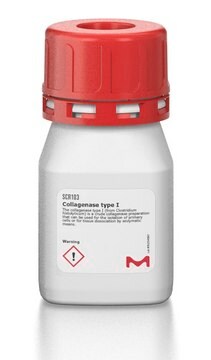C9697
Collagenase aus Clostridium histolyticum
lyophilized powder (from 0.2 μm filtered solution), suitable for cell culture
Synonym(e):
Clostridiopeptidase A
About This Item
Biologische Quelle
Clostridium histolyticum
Qualitätsniveau
Sterilität
0.2 μm filtered
Form
lyophilized powder (from 0.2 μm filtered solution)
Spezifische Aktivität
≥800 units/mg solid
Mol-Gew.
68-130 kDa
Konzentration
1 mg/mL
Methode(n)
cell culture | mammalian: suitable
pH-Wert
7.4
Lagertemp.
−20°C
Suchen Sie nach ähnlichen Produkten? Aufrufen Leitfaden zum Produktvergleich
Allgemeine Beschreibung
Anwendung
- Sertoli cell isolation
- Used in the comparison of enzymatic methods
- Tissue preparations for immunocytochemistry
- Testicular sperm extraction
- Preparation of single cell suspensions
- Immunofluorescence
This product is suitable for the disaggregation of human tumor, mouse kidney, human adult and fetal brain, lung and many other epithelia tissues. It has also been shown to be effective in liver and kidney perfusion studies, digestion of pancreas and hepatocyte preparation. Collagenase has also been used in the preparation of arterial tissue for the study of Advanced Glycosylation End Products. This enzyme has been tested for the release of heptatocytes at a concentration of approximately 1mg/mL. Concentrations for digestion range from 0.1 to 5mg/mL.
Biochem./physiol. Wirkung
Vorsicht
Einheitendefinition
Angaben zur Herstellung
Ähnliches Produkt
Signalwort
Danger
H-Sätze
Gefahreneinstufungen
Eye Irrit. 2 - Resp. Sens. 1 - Skin Irrit. 2 - STOT SE 3
Zielorgane
Respiratory system
Lagerklassenschlüssel
11 - Combustible Solids
WGK
WGK 1
Flammpunkt (°F)
Not applicable
Flammpunkt (°C)
Not applicable
Persönliche Schutzausrüstung
dust mask type N95 (US), Eyeshields, Faceshields, Gloves
Analysenzertifikate (COA)
Suchen Sie nach Analysenzertifikate (COA), indem Sie die Lot-/Chargennummer des Produkts eingeben. Lot- und Chargennummern sind auf dem Produktetikett hinter den Wörtern ‘Lot’ oder ‘Batch’ (Lot oder Charge) zu finden.
Besitzen Sie dieses Produkt bereits?
In der Dokumentenbibliothek finden Sie die Dokumentation zu den Produkten, die Sie kürzlich erworben haben.
Kunden haben sich ebenfalls angesehen
Protokolle
This procedure may be used for Collagenase products.
Unser Team von Wissenschaftlern verfügt über Erfahrung in allen Forschungsbereichen einschließlich Life Science, Materialwissenschaften, chemischer Synthese, Chromatographie, Analytik und vielen mehr..
Setzen Sie sich mit dem technischen Dienst in Verbindung.



